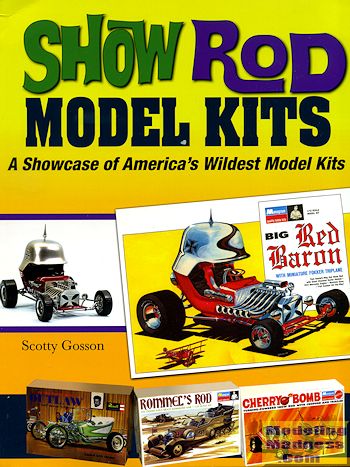 Many of us
consider ourselves eclectic modelers. What that means is that we build all sorts
of subjects. We are not focused on one subject like US Tanks, WWII Luftwaffe,
British ships or NASCAR racers. However, there are folks who are what we would
call niche modelers in that they do concentrate on one specific are of the
hobby. Fortunately for all of us, there are a lot of subjects from which to
choose, no matter how concentrated one's interest may be.
Many of us
consider ourselves eclectic modelers. What that means is that we build all sorts
of subjects. We are not focused on one subject like US Tanks, WWII Luftwaffe,
British ships or NASCAR racers. However, there are folks who are what we would
call niche modelers in that they do concentrate on one specific are of the
hobby. Fortunately for all of us, there are a lot of subjects from which to
choose, no matter how concentrated one's interest may be.
One of those niche areas is that of Show Rods. These are cars
whose sole reason for being is auto shows. They are often of a wild or
futuristic design and not based on any extant vehicle, or if so, is nearly
unrecognizable as what it was. These do not have to be 'T-bucket' based cars,
though many do have that sort of a format. Widely considered to be the first
show car is the Lincoln Futura, which was kitted by Revell in 1956. This is also
considered to be the first show car kit, along with the Pontiac Club de Mer,
released in the same year. As many know, the Futura was eventually purchased by
George Barris who turned it into the first Batmobile.
The show rod era in models ran from the mid 1950s until the
end of the 1960s, though there is no really firm date for its demise. Throughout
that time period, some very well known kits like the Beatnick Bandid, Predicta,
Beer Wagon, Rommel's Rod, Munster Koach, and many more were produced. Many of
these kits were not based on real cars while some others were. Some show cars,
like the Red Baron, were based on extant kits! A few of these kits were wildly
popular with the author stating that some sold 11 million copies, a figure that
is truly exceptional.
However, that era of modeling is past and will probably never
be seen again. Modern kit makers want to do variants on a kit and those kits of
the 50's and 60's were one car molds. Fortunately for those who like the genre,
it is no longer a requirement to pay a small fortune for these old kits as Round
2, who bought AMT and MPC, have been slowly reissuing these kits, while Revell
USA has been doing the same for those kits under its and Monogram's name. In
some cases, the older kits have not survived and so, as in Rommel's Rod, it has
been newly tooled. Yet others have never been reissued, though there is an
excellent chance that if the molds are still viable, they will. One thing I have
seen in some reissues is the company fixing errors in the original, which is
really nice.
The author has written a fine book on this niche of car
modeling that includes a history of many of the kits along with any reissues
that have been done. This is accompanied by box art photos and sometimes images
of the completed model. There are also several chapters of questions and answers
involving not only some of the men who designed these kits, but enthusiasts and
the head of Round 2. You would expect a section on collecting these cars and
that is also included as is an interesting section on modelers who scratchbuild
these sorts of cars. I can recall in my youth being able to pick up modeling
magazines and having them showcase the work of some truly talented
scratchbuilders and kitbashers, so this section was of interest to me.
In all, it is an outstanding look at the subject and a book I
can quite easily recommend to those with an interest in show rods or those who
just like models.
February 2015
Review book courtesy of
 ,
where you can order your copy of this and many other superb aviation and
modeling books. Visit their website at the link above or call them at
1-800-895-4585
,
where you can order your copy of this and many other superb aviation and
modeling books. Visit their website at the link above or call them at
1-800-895-4585
If you would like your product reviewed fairly and fairly quickly, please contact
the editor or see other details in the Note to
Contributors.
 Many of us
consider ourselves eclectic modelers. What that means is that we build all sorts
of subjects. We are not focused on one subject like US Tanks, WWII Luftwaffe,
British ships or NASCAR racers. However, there are folks who are what we would
call niche modelers in that they do concentrate on one specific are of the
hobby. Fortunately for all of us, there are a lot of subjects from which to
choose, no matter how concentrated one's interest may be.
Many of us
consider ourselves eclectic modelers. What that means is that we build all sorts
of subjects. We are not focused on one subject like US Tanks, WWII Luftwaffe,
British ships or NASCAR racers. However, there are folks who are what we would
call niche modelers in that they do concentrate on one specific are of the
hobby. Fortunately for all of us, there are a lot of subjects from which to
choose, no matter how concentrated one's interest may be.